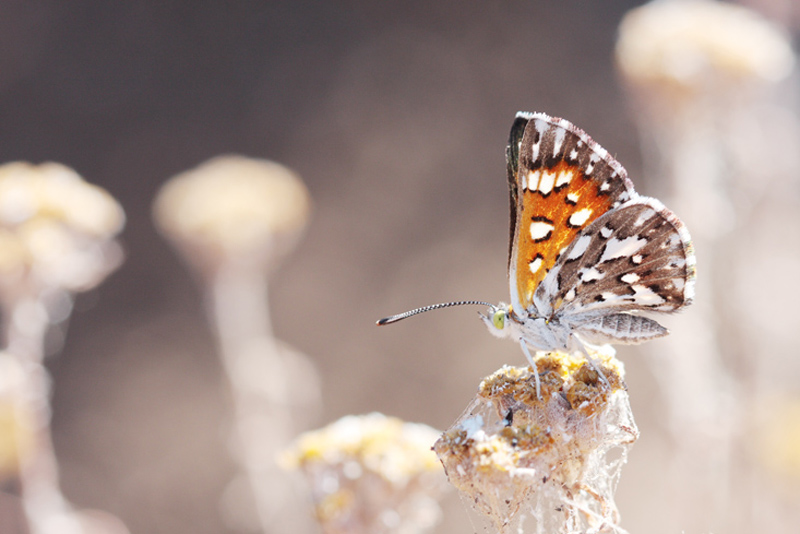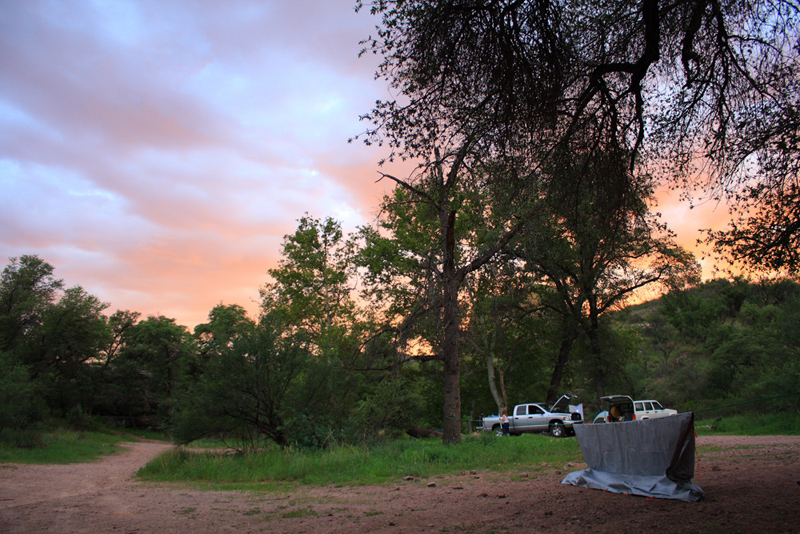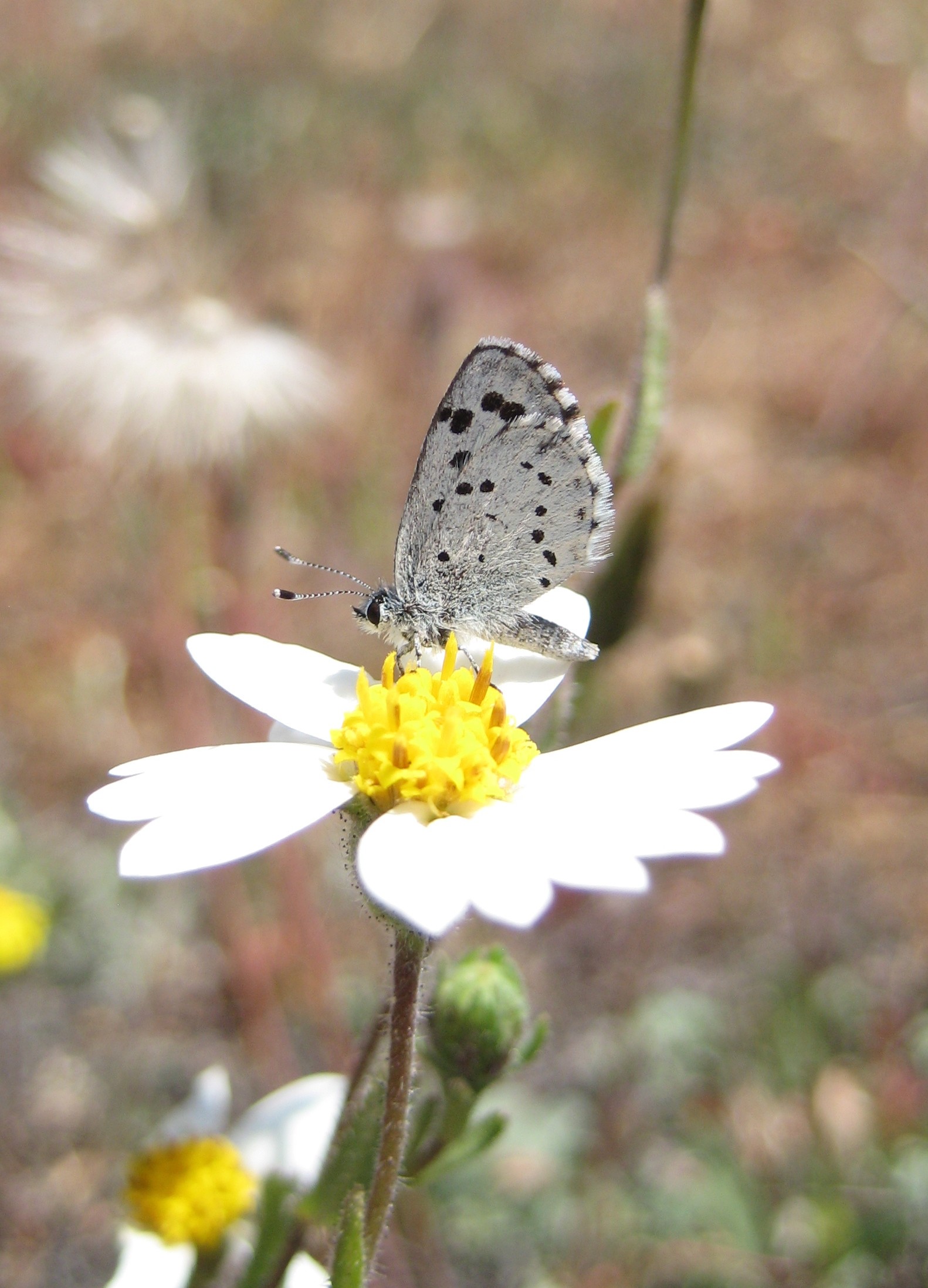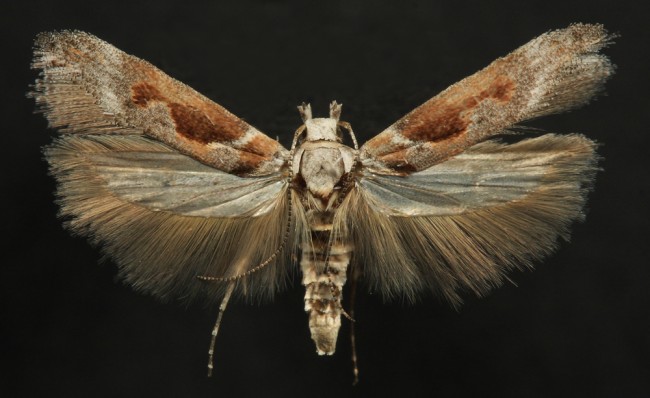דורך קריס גרינטער, אויף פעברואר 24, 2010

וויסן דעם פלאַטערל? עס ס גוט, קיין איינער טאַקע טוט. עס איז אין די מין אַפּאָדעמיאַ (ריאָדינידאַע), אָבער די טאקסאנאמיע פון דעם גרופּע איז אַ ומגליק… און טאָן ניט אפילו באַקומען מיר סטאַרטעד אויף די סובספּעסיעס. דעם ספּעסאַמאַן איז פאָוטאַגראַפט אין סעפטעמבער, טייַטש עס איז רובֿ מסתּמא צו זיין אַפּאָדעמיאַ מאָרמאָ (מאָרמאָן) based on flight time. א. מאָרמאָן is a fall flyer and א. virgulti is a spring flyer. While some forms seem distinctive, there is massive morphological overlap and they are usually identical and sympatric – actually down to living on the same plants. But according to lab experiments it is impossible to get the pupae to break diapause so they remain reproductively isolated. So are they different? While molecular work is being conducted the verdict is out, but it does seem like these two species may be retained in the end. און פון קורס, each mountain range has it’s own subspecies. Who knows, I sure don’t. I’m glad I don’t work on butterflies.
Species concepts are a fuzzy line and it’s never clear exactly where to make the cut. When asked what a species is most people default to the Mayr concept of Biological Species (BSC), where reproductive isolation = new. This is all well and good but we have to keep in mind that this is not the ONLY species concept. עס זענען דאַזאַנז, and not one is perfect. Groups like Grammia (נאָקטוידאַע: אַרקטיינאַע) exhibit high levels of hybridization, which does not adhere well to the BSC. I like to apply as many criteria as possible to delimit a species and it seems like the line is all too commonly thin within insects. I like to see a distinguishing morphological trait, if not in wing color or pattern, at the least in the genitalia or antennae. This is not always the case however and you have to look at the biology and/or DNA. I have looked at two insects that are for all intents and purposes identical. But the biology is radically different and a large % difference (over 8% – יאָ, arbitrary) in their DNA makes it unquestionable that they are separate.
And if species weren’t contentious enough subspecies stir the pot even more. I’m skeptical about the entire concept, but there are cases in which it seems plausible and necessary. A subspecies is a more formal definition of a geographical “פאָרעם” and usually exhibits a blend zone into another subspecies. For instance if you look at the 27 different populations of Plebejus icarioides there are large differences between northern and southern populations, but very subtile difference along the gradient. It is that persistent gradient that creates one dynamic species instead of 27 separate species – at least according to current research. Moths have been lucky and have thus far avoided the plague of over-subspeciation, butterflies not so much. There may even be instances where greedy collectors have named new subspecies of Parnassius for profit (new rare butterfly subspecies sell for big bucks).
The truth is that species concepts are artificial, poorly understood and dynamic at best; at worst it approaches a soft science with no real possibility of proof. Yet species are real and theories will continue to adapt while we sit here and scratch our heads.
דורך קריס גרינטער, אויף פעברואר 23, 2010 

איינער פון די פּערקס פון זייַענדיק אַ ענטאָמאָלאָגיסט איז טראַוואַלינג און קאַלעקטינג. איך שטעלן אַ ביסל טויזנט מייל אויף די מאַשין יעדער זומער און די זענען צוויי פון די בעסטער ערטער אין אַריזאָנאַ צו זאַמלען. די שפּיץ בילד איז פון די באַבאָקוויוואַרי בערג (באַבאָקוויוואַרי פּיק אין די מיטל), ברוין קאַניאָן פאָרשונג סטיישאַן. The bottom image is of Pena Blanca Canyon, a famous collecting hotspot. This canyon is just 5 miles from Mexico and has a few safety concerns because of our current immigration policy. One morning, while sorting moths from the previous nights catch, a colleague and I had a group of roughly 30 illegals walk right through our camp. They were well dressed and clean, waved, and must have just been dropped off at the fence. Thankfully the majority of illegals are hard-working and honest people trying to earn a better life. It’s the coyotes and smugglers that are scarier – I have heard tales of Mexican police escorting drug caravans into the US with heavy artillery. And just last year a border patrol agent was stabbed to death by a coyote in this vicinity.
טאַנגקפאַלי, a bunch of strange guys standing around strange lights at nights grants us a wide berth.
(Are these images small enough to load quickly?)
דורך קריס גרינטער, אויף פעברואר 23, 2010 טראָץ זייַענדיק שיין דיסינריסטיד אין באַטערפלייז, זיי זענען שיין צו קוקן בייַ. דאָ איז אַ טאַקע גרויס ווידעא דורך אַ באָכער איך וויסן אַראָפּ אין סאָוטהערן CA. זיין צייַט-לויפן ווידיאס פון לעפּידאָפּטעראַ לעבן סייקאַלז זענען שיין ימפּרעסיוו, און דעם איינער אין באַזונדער איז שיין. אויב איר שנייַדן צו וועגן 3:00 אין, you will see dozens of Great Purple Hairstreaks (Atlides halesus) emerging from their chrysalises, the colors are stunning. This butterfly is native to the SW and Mexico, and I have to admit I love finding it in the field.
[יאָוטובע=הטטפּ://www.youtube.com/watch?v=KyWJlpIchkE]
דורך קריס גרינטער, אויף פעברואר 23, 2010 The brief comment about Linus Pauling and Vitamin C below made me remember this video first posted a while ago by פאַרינגולאַ. דעם איז קערי מאַליס, די ינווענטער פון פּקר, און אַ נאבעל פרייז געווינער. זיין דערפינדונג בייסיקלי געמאכט דנאַ אַנאַליסיס מעגלעך. אבער ווי פּאָלינג, ער איז אויך גאָר און טאָוטאַלי ניסלעך. If you have the time to listen to him ramble, give it a shot. אבער בקיצור, he discusses astrology, denies global warming and how AIDS is not caused by HIV. I wonder what the stats are for genius scientists that slide off their rocker?
[Vimeo 9167379]
דורך קריס גרינטער, אויף פעברואר 22, 2010 
דעם איז אַן אַלט בילד פון מייַן, אַזוי עס ס ניט גאנץ. אויב איר קענען זאָגן מיר דעם פלאַטערל צו מינים איר באַקומען אַ הויך פֿינף. אויב איר וויסן די סובספּעסיעס, איך וועט שיקן איר אַ נייַ באַנדע פון #3 ומבאַפלעקט שטאָל פּינס! בלויז אָנצוהערעניש: עס ס פון די מערב USA.
דורך קריס גרינטער, אויף פעברואר 22, 2010 Today I found דעם article in NY times health – טאָוטינג די בענעפיץ פון אַקיופּאַנגקטשער געניצט פֿאַר דעפּרעסיע רעליעף אין שוואַנגער פרויען. איך האָבן אַ ביסל פּראָבלעמס מיט די זשורנאַליסט, שירליי ד. וואַנג, פיילינג צו בלייַבן סקעפּטיקאַל אין איר שטיק. אבער דעם קומט ווי קיין יבערראַשן, so I won’t bother to point out obvious flaws in the media.
I will point out the flaws in the study. Please find the original full text, דאָ. So after reading this paper I have come to a few conclusions.
1) Very small sample size of 150 patients, בלויז 141 treated.
2) The study is blinded ONLY for the depression scoring, not administration of acupuncture. אין פאַקט, their release form states “Participants in one of these two groups will receive acupuncture that focuses on depression symptoms and the other treatment will not.” Makes sense, getting a needle shoved in your skin is easy to notice. אַזוי, these “randomized and blinded” participants knew what was coming and assumed that any poking was supposed to help their depression. דערצו, דעם (much better) study has shown that simulated acupuncture with toothpicks works just the same. Careful, this is compelling evidence against the validity of acupuncture – not evidence for the usefulness of stimulated “pressure points”. It is a placebo effect.
3) Study assumes validity of “depression specific” און “non-specific” acupuncture. Meaning one method of pin sticking somehow cures depression over another. What is this based on? Oh wait, they say exactly the exhaustive scientific evidence right here: “patterns of disharmony according to the principles of traditional Chinese medicine”. I’m sorry, please, give me modern medicine over 2,000 year old mythical beliefs. How was the average quality of life and life expectancy for an ancient chinese person? Pretty damn horrible, and I’m sure the average life expectancy did not exceed 35 יאָרן.
4) Basing depression scores on one administration of the DSM-IV Hamilton Rating Scale. Not being a psychiatrist I can’t speak to the efficacy of these tests. אבער, I will go out on a limb and assume that a stronger baseline for depression should be established before comparing results. The test may be accurate, but why not administer it more than once to reduce noise.
5) Selection of massage as a second control. This is a bad attempt at token skepticism, they even state right off the bat “Massage was conceptualized as a control treatment because, although it improves mood immediately after a session, there is insufficient evidence to support its efficacy as a treatment for depression.” When I design a study I like to look at all known factors that I believe will disprove my hypothesis. Choosing something that you already believe will fail only shows their hand of gross bias.
6) Failure to control for socioeconomic factors. 67% of the participants were white, the majority of which were well-educated. They even go as far as to state in the discussion “דעריבער, results might not generalize to specific minority groups that were underrepresented in our sample”. Is it just me, or does this statement negate the entirety of their research? They are freely admitting that acupuncture might not work as well in other minority groups. Why could this be? The only logical and scientific answer is that a placebo effect differs across socioeconomic boundaries. If, after all, acupuncture was a legitimate medical science, there would be an insignificant difference seen across physiologically identical organisms.
This study is appallingly bad science. These researchers are beginning with the premise that acupuncture works, and searching for data to support their claims. This is exactly opposite of how to conduct real science. און, our health reporter at the NY Times didn’t even bat an eye. Fail for you Mrs. וואַנג, and fail to the NY Times.
דורך קריס גרינטער, אויף פעברואר 21, 2010 איך ליבע מינג סיי און זיין קוקינג אימפעריע ווי פיל ווי דער ווייַטער 3-בין טעלעוויזיע צוקוקער. פאקטיש, his recipes are fantastic and you should make them yourself. אבער איך האָבן באמערקט אַ מאָדנע טענדענץ פֿאַר אים צו זאָגן (פּאַראַפראַסעד) “איר זאָל שטענדיק נוצן אָרגאַניק, עס ס פיל בעסער פֿאַר איר”. דעם בלעטער מיר אַ ביסל פּאַזאַלד. What exactly does he mean? Ming is well-educated and this is not anything he should be solely responsible for, but he echoes an all too common misconception that organic is actually better. By better I am interpreting this as healthier, which seems to be a logical gap to bridge. אַזוי, let’s look at the data.
A recent and comprehensive review published in the American Journal of Clinical Nutrition has largely convinced me of what I was always skeptical of; that organic foods can not actually be healthier for you. In their breakdown they cited 55 studies and came to the conclusion that “there is no evidence of a difference in nutrient quality between organically and conventionally produced foodstuffs”.
So what is the harm? My problem with all of this is that it is based on the naturalistic fallacy, that “natural” אָדער “organic” somehow means that the product is safer or healthier. How many times do you see the term “natural” in the store and never give it second thought? If natural things really were safer then traditional Ayurvedic medicines would not be horribly toxic. Afterall, arsenic, lead and mercury are NATURAL – but they are also some of the most toxic compounds known to man. In the end it is 100% marketing.
Taken from another angle Ming Tsai may not be all that incorrect afterall. I do not have all the data in front of me regarding pesticide contamination of foodstuffs, but it is logical to assume the less contaminated the better. Obviously pesticides can be a bad thing, there are mountains of literature to support the damage they can cause. But the jury seems out on exactly how bad, if at all, these minute residues on our foods are. Conventionally grown foods have regulated levels of residues, but even organics are not free of pesticide contamination. So I look at it differently. Our environment benefits from having safer food. Less chemicals are dumped into our waterways, farmers have to battle less with incredibly powerful toxins, און blinky the fish fights to see another day. We should all strive to live sustainably and organic farming does provide us with an edge.
So once again, what is the harm? People who buy organic quite possibly do so based on genuine environmental stewardship. I would also argue that a very high percentage of these people also believe these foods are healthier (anyone have survey data to support this claim?). So in this instance the result is a net positive. אבער, being right for the wrong reasons should never be acceptable. This strikes at the peak of a larger problem that is driven by marketing and zero science. Case in point – Vitamin C as a cold remedy. A study in PLOS medicine has shown there is no indication for efficacy of VitC against the common cold. גייט פיגור, a once believed to be true staple has begun to be picked apart by science and data. Let’s be careful on what bandwagon we jump and why.
דורך קריס גרינטער, אויף פעברואר 21, 2010 [יאָוטובע=הטטפּ://www.youtube.com/watch?v=zSgiXGELjbc]
איך טאַקע הנאה דעם אַוטאָטונעד סאַגאַן, מאכט מיר מיט איך איז געווען דעם עלאַקוואַנט. Watch more videos here at the Symphony of Science.
דורך קריס גרינטער, אויף פעברואר 21, 2010  אַזוי, how do I begin a new blog? Tough question, but perhaps this is a good time to show off a fun new species. This moth was collected last year outside of Santa Barbara, CA. The massive wingspan, at 15mm, makes it pretty large for a Gelechiid moth. The genus, Gnorimoschema (pronounced nor-a-mosh-ma), seems to be far more species rich than is currently known, so this creature comes as no surprise. It also gives me a chance to brag about the benefits of studying such a wonderfully diverse group of animals. If you happen to be lucky enough to be a friend of mine you’ll probably get your own species at some point. אַזוי, how do I begin a new blog? Tough question, but perhaps this is a good time to show off a fun new species. This moth was collected last year outside of Santa Barbara, CA. The massive wingspan, at 15mm, makes it pretty large for a Gelechiid moth. The genus, Gnorimoschema (pronounced nor-a-mosh-ma), seems to be far more species rich than is currently known, so this creature comes as no surprise. It also gives me a chance to brag about the benefits of studying such a wonderfully diverse group of animals. If you happen to be lucky enough to be a friend of mine you’ll probably get your own species at some point.
אויף די אנדערע האנט, this also highlights the problem – knowing almost nothing about the most diverse group of animals on our planet. What happens when a new crop is being eaten by a tiny, nondescript, מאָל? Call one of the dozen people in the world who might be able to help you. Maybe they know what it is, but likely nothing is known about its biology. This is what happened in South Dakota recently when biofuel crops were being eaten by a moth last seen in 1910. What a perfect reason for more funding! More likely than not my new moth above will never explode into a pest. But having basic knowledge of the species that share this earth with us is a step in the right direction.
|
סקעפּטיסיזאַם
|





